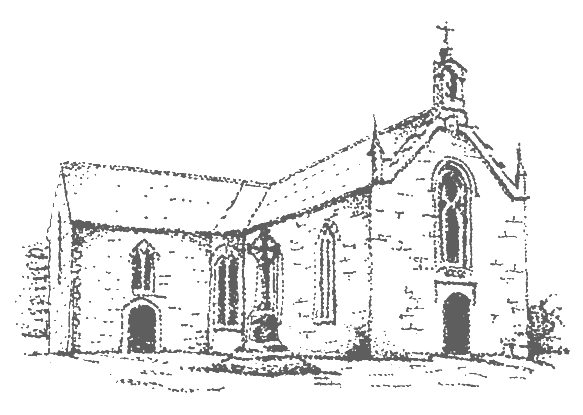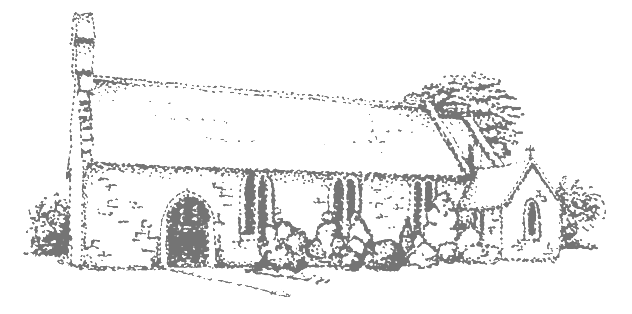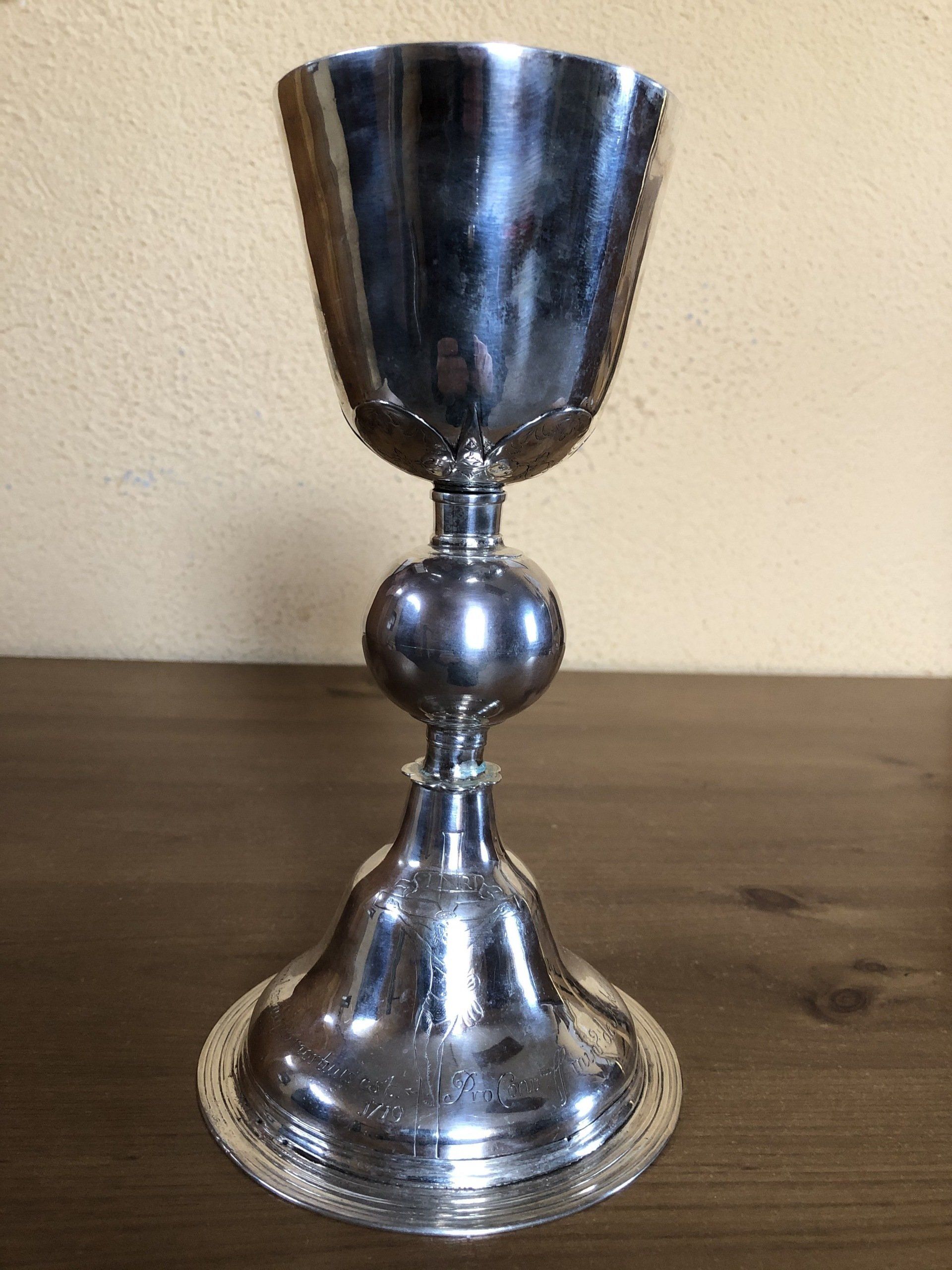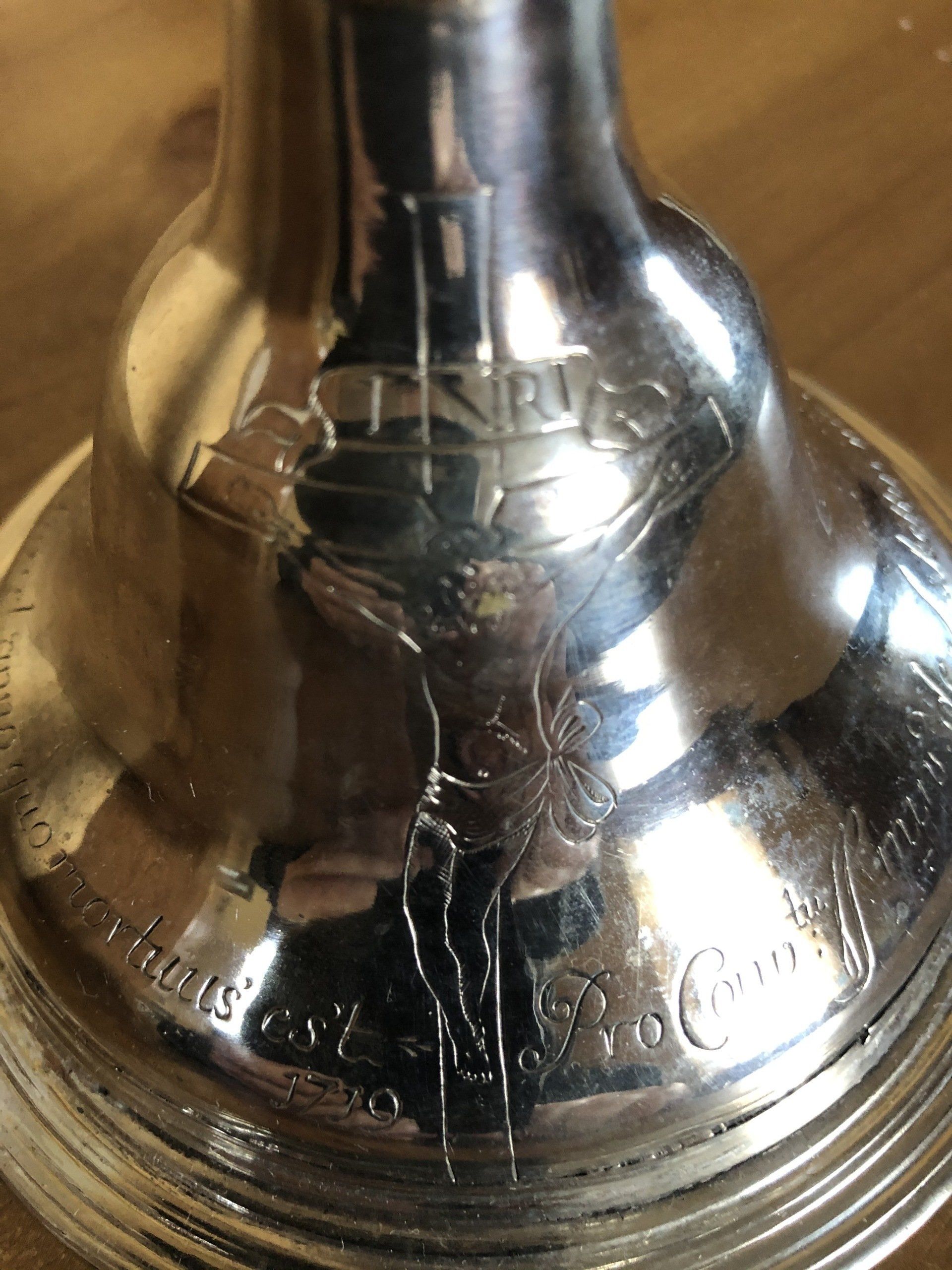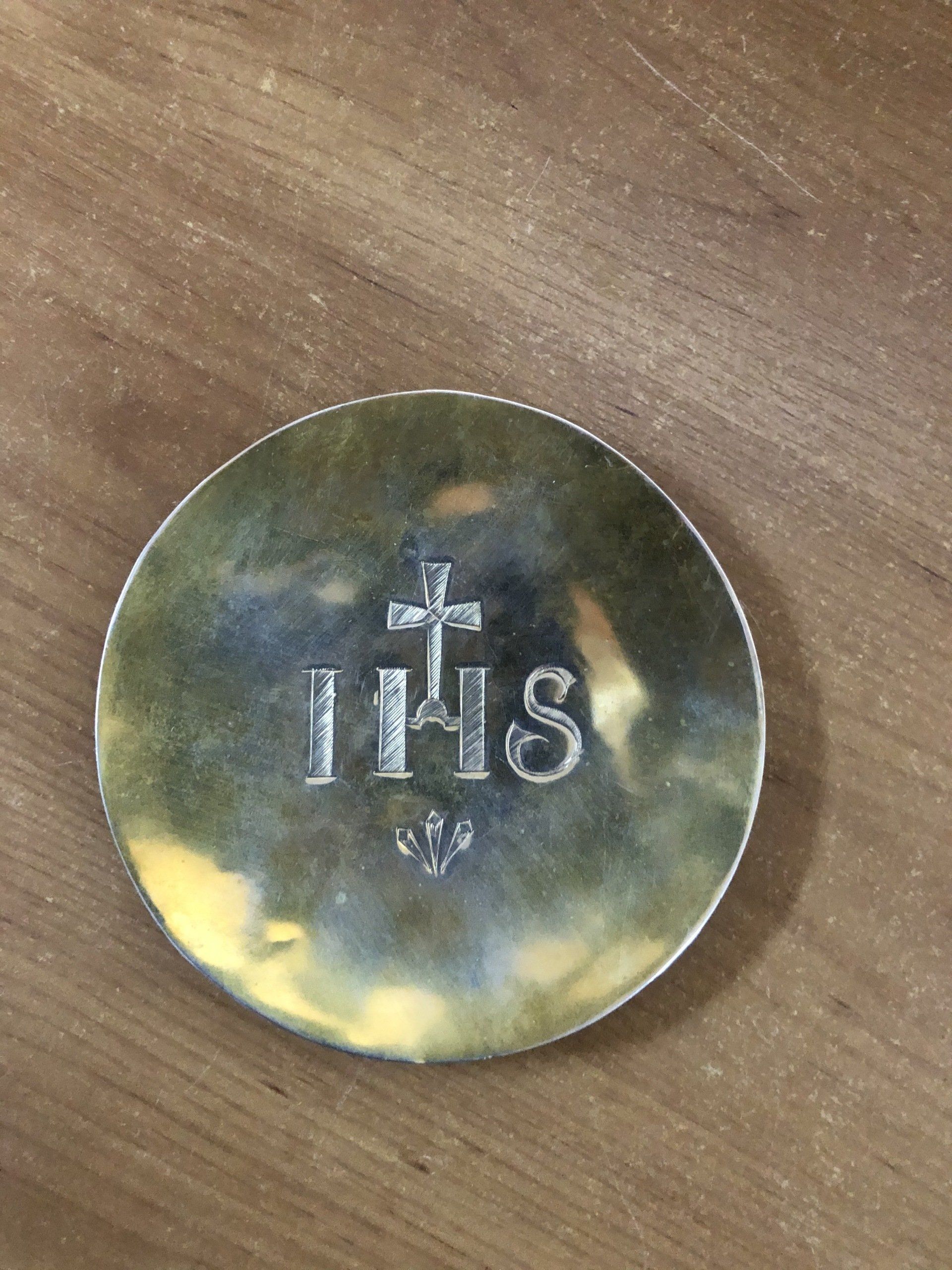Purcel Chalice
The Purcel Chalice is a simple, unpretentious but beautiful, silver chalice. It stands about 9” (23cm) tall. It bears the Latin inscription:
Pro Conventu. ff min. de Askettin me Super permissu fiere curavit fr. Pat Purcel anno quo mortuus est 1719
This translates as:
‘For the Convent of the friars minor at Askeaton, with the Superior’s permission, Fr. Pat Purcel arranged to have me made in the year of his death 1719’.
The cup can be screwed on, or off from, the leg. On the leg the crucifixion is depicted as well as bearing the above inscription.
We celebrated the 300th anniversary of the chalice on the 8th December (2019), Feast of the Immaculate Conception and Askeaton church feast day.
Unfortunately, we have no definite knowledge as to the whereabouts or history of the chalice across about two centuries, and just a little information about Fr. Pat Purcel. Fr John Begley, who ‘progressed’ from curate to Canon to Archdeacon in the course of writing his celebrated three-volume history of, The Diocese of Limerick, has this to say in the final volume:
‘David Lacy was registered in 1704 as pastor of Askeaton, Lismakeery and Toomdeely. Four years later he was being suspected of having Jacobite sympathies and had to give security. He was indicted for being a Popish priest that had not taken the Oath of Abjuration in 1714 and 1719, but there is no record of his having been arrested. The date of his death is unknown. There were Franciscan fathers about their monastery, and, though not living therein, they ministered in the locality. In the parochial church there is a beautiful silver chalice with the inscription…. (quoted as given above). Evidently the inscription was inserted after his (Fr. Purcel’s) death. In 1715 Purcel was reported as “a reputed friar who commonly inhabits Tulla, Co. Clare, and officiates.” When being pursued by the Government he must have crossed the Shannon to Askeaton and vice versa.’
We know that the Franciscans continued by and large to maintain a presence in Askeaton in the environs of the Abbey even after the Abbey was sacked by Malby in 1579. In fact, the Catholic Confederate forces occupied the castle in 1642 and were instrumental in having the Abbey partially restored the following year. Thereafter a Guardian is recorded as being present in the Abbey up to 1714. The old parish church, which was burned in 1847, was situated in the grounds of the Abbey. Is it unfair to surmise that the chalice remained in this environment where Mass was frequently offered, even after the Franciscans were replaced by Diocesan priests, before being transferred to the present church? As a result of the historical gaps and with some reluctance I tell the story of the chalice from my own point of view, a much more recent narrative, but that is all that is available to me.
I was transferred to the parish of Askeaton-Ballysteen as curate in September 1996. The following September (1997) I was appointed Parish Priest. One day, while clearing out some presses in Askeaton church with the sacristan, Mrs. Eileen Shields, we came across a box at the back of one of the shelves. To our surprise, and I may say, delight, it contained the Purcel Chalice. Neither of us had ever heard of the existence of the chalice before then, though I later discovered that it had been documented elsewhere previously (as in Fr. Begley’s history) and was obviously known to my predecessors.
I began using the chalice on important occasions such as Masses on Christmas ‘Eve, Holy Thursday and the Easter Vigil, though there was a notch on the leg at the point where the cup screws into it. Eventually at one Christmas ‘Eve Mass, as I was taking back the chalice from one of the Eucharistic Ministers, between us we gave the chalice some kind of a jerk which increased the size of the notch. Thereafter it was dangerous to use the chalice lest the Precious Blood be spilt or the chalice further damaged.
For a number of years I wondered what could be done to repair the chalice. I thought of taking it to one of the jewellers in Limerick but further considered that they might not have the expertise, or indeed the reverence, to deal with such an important vessel. Then, one day, it dawned on me! The Curator of the National Museum was Dr. Pat Wallace, a native of Askeaton. If anybody could help us it was undoubtedly he. Sure enough, when I contacted him Pat arranged for me to visit the museum with the chalice for help.
I brought the chalice to Dublin on 27th November 2008. I didn’t meet Pat himself as it happened he was ill at the time, but I left the chalice in the care of the museum. The experts there had undertaken to examine the chalice and to advise on the options we had.
In the interim before returning to the National Museum to meet the experts we were clearing out a press (again!) under the stairs. I came across a paten. The paten featured the Chismon (‘IHS’ logo) and a figure of three nails underneath the logo. I wondered, could this paten be a companion to the chalice? It would match up with the depiction of the Crucifixion on the leg of the chalice.
I was back in Dublin on 21st January 2009. When I visited the museum again Dr. Pat was present with his team of experts. The first thing I mentioned was the paten and before I had shown it to them the experts were all of the one opinion that it wouldn’t have belonged with the chalice. However, as soon as I showed it to them they changed their minds and agreed that it was. They then advised that the chalice could be repaired by them. One of the team suggested that it should not be repaired at all as it would interfere with the authenticity of the chalice. While I understood the point he made I offered the view that the chalice is a liturgical vessel and has its context within a worshipping community, so that community should be able to use it in their celebrations. Somebody else asked if we might sell the chalice to the National Museum but to that I replied that it belonged to the people and the parish of Askeaton and Ballysteen and that that is where it should remain. Pat then asked permission to x-ray the chalice to help determine its exact age; he pointed out that it was likely that the original cup had become worn out, due to the fact that that is the part that the celebrant of each Mass would be handling most, and so it might have had to be replaced. The implication was that the cup might not be as old as the leg.
Before I left the museum Pat suggested that I visit Collins Barracks where there was an exhibition of Franciscan chalices taking place. This exhibition was quite informative. There were chalices from the mid-17th century that were quite large and ornate and not at all as simple as our chalice. I realised that this was the period of the Confederation of Kilkenny and a brief interlude of Catholic political supremacy in Ireland, and so Catholics were in a position to have such chalices manufactured and used openly in worship.
I surmised that the reason that the Purcel Chalice was so much smaller and less ornate and that the cup and the leg could be separated was due to the political conditions in the country at the time. It was the time of the Penal Laws which made it illegal for the people to attend Mass and a serious offence for any priest to celebrate Mass. The size of the chalice and the possibility of separating the cup from the leg made it easier to hide the chalice.
It is also interesting that, unusually, the chalice carries no stamps of any silversmith or of where it was fashioned. This is a further indication that the silversmith who made the chalice did not want to be identified, lest he draw the authorities down on his head. However, the best guess is that the chalice was fashioned in the environs of Dublin.
Pat himself delivered the chalice back to me in the parish on 15th May 2009. He had another piece of interesting information. To his surprise the cup of the chalice is in fact older than the leg, dating probably from the 1690s. It is interesting to ponder what might have happened to the original leg of the chalice. Was it Fr. Purcel himself who lost or damaged the leg and so felt the obligation to replace it, or had the leg simply gone missing? And who, then, was responsible for having the original chalice fashioned? We can only surmise.
Sunday, 8th December 2019 brought high winds and rain, thunder and lightning, hailstones and sunshine. It might well have been a metaphor for the varying experiences of the people of the parish and their faith over the lifetime of the chalice. On that day God our Father called together his people to worship as He has done for centuries in this parish. We gathered round our bishop, Breandán Leahy, to celebrate the Eucharist. It was a joyous occasion. Afterwards we shared refreshments in the Parish Meeting Room. It was a fitting commemoration of the 300th anniversary of the Purcel Chalice.
What is certain now is that whenever we celebrate the Eucharist with the Purcel Chalice we are participating in a long tradition of faith and our very celebration puts us in direct connection with our forebears. We hope and pray that the generations that follow us may be proud of the rich and living heritage they have had passed on to them.
(This piec e was first written as an article for the ABC News 2019 -the ABC News is an annual publication by Askeaton-Ballysteen Community Council)
